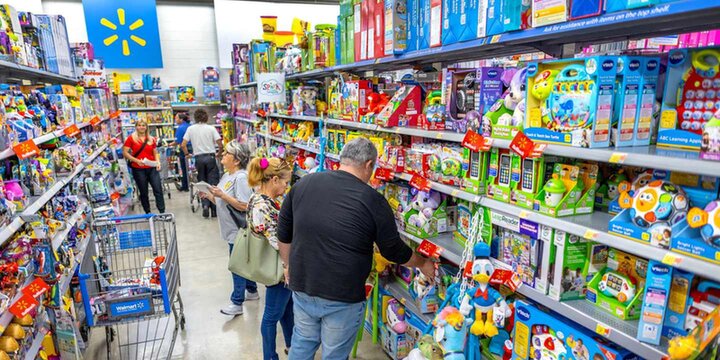From Sustainability to Automation: Walmart’s Recipe for Grocery Dominance

Walmart has long held its title as the largest grocery retailer in the U.S., operating more than 4,600 stores across the country. But Walmart’s success isn’t just in its vast number of locations or its competitive pricing; it’s in its commitment to technological innovation, which enables the company to adapt to changing consumer behaviors and continuously improve the customer experience. By leveraging advanced technology, Walmart is transforming how groceries are delivered, processed, and experienced both online and in-store, positioning itself as a leader in the rapidly evolving retail landscape.
Walmart’s investment in technology is at the core of its recent growth strategy, especially within the grocery sector. This is evident in the company’s ongoing implementation of automated distribution centers (DCs). Walmart has introduced high-tech perishable DCs in key locations, including Shafter, California, and Lancaster, Texas, with plans to expand to South Carolina, Illinois, and New Jersey. These centers have doubled capacity and productivity, allowing Walmart to move products more efficiently and reduce delivery times to stores.
The automation process includes robotic systems that inspect, store, and retrieve cases in temperature-controlled environments. The technology also optimizes store deliveries by organizing pallets by department, making it easier for employees to unload items efficiently. This type of automation reflects Walmart's dedication to using technology to reduce operational costs while enhancing customer service by ensuring fresh produce, dairy, and other perishables arrive on shelves in optimal condition.
Walmart’s e-commerce platform has witnessed significant growth in the last few years, driven by the pandemic-induced shift towards online shopping. In 2024, Walmart saw e-commerce sales grow by 22%, further solidifying its position as a leader in online grocery retail. The retailer is using its extensive store network to fulfill orders, with more than 50% of online grocery orders now being fulfilled by local stores. This strategy allows for faster delivery times, with many orders reaching customers in under an hour.
By implementing generative AI and other digital technologies, Walmart has enhanced its ability to predict consumer needs and streamline the shopping experience. AI allows the company to personalize recommendations, manage inventory more effectively, and automate restocking processes, improving operational efficiency and reducing the likelihood of out-of-stock items.
At Walmart, we’re committed to harnessing the power of technology to meet the changing needs of our customers, while maintaining our core mission of delivering everyday low prices.

E-commerce: Scaling to Meet Consumer Demand
Expanding Technological Horizons in Grocery
As consumers increasingly shop through multiple channels—online, in-store, and mobile—Walmart has embraced an omnichannel approach to meet these diverse needs. Its Store Assist technology, which helps employees manage orders for pickup, delivery, and ship-from-store services, ensures smooth and efficient operations across platforms. Walmart has also integrated electronic shelf labels (ESLs) in more than 2,300 stores, enhancing in-store processes by allowing employees to quickly update prices and replenish products using digital cues.
In line with its omnichannel strategy, Walmart has also expanded its InHome delivery service, where trained Walmart associates deliver groceries directly to customers' refrigerators or garages. This service, which is available to 45 million households in 50 markets across the U.S., has proven popular among busy consumers who seek convenience. The service is an add-on to Walmart’s Walmart+ membership program, further enhancing customer loyalty by bundling services under a single subscription.
Walmart’s leadership in grocery retail is not just about technology and convenience; it’s also about sustainability. The company is taking bold steps to reduce food waste with the implementation of the Zero Depack program, developed in collaboration with Denali, an organics recycler. Through this initiative, Walmart has installed depackaging technology in over 1,400 stores, allowing expired or unsalable food to be separated from its packaging. This technology helps Walmart divert food waste from landfills, converting organic material into nutrient-rich biosolids for farmers.
By 2030, Walmart aims to cut operational food waste by 50%, aligning with broader sustainability goals. This focus on reducing waste, recycling, and supporting sustainable farming practices not only helps the environment but also strengthens Walmart’s brand as a socially responsible retailer.
Omnichannel Experience: Seamlessly Connecting Digital and Physical
Sustainable Innovation: Leading the Charge on Waste Reduction

Another key area where Walmart continues to excel is through the expansion of its private label brands, particularly in the grocery sector. In 2023, Walmart launched Bettergoods, a new grocery brand that focuses on providing high-quality food at an affordable price. The Bettergoods line is part of Walmart’s strategy to attract price-conscious shoppers while maintaining a focus on health and sustainability.
Private labels like Bettergoods play a crucial role in Walmart’s grocery strategy by offering customers alternatives to national brands, often at a lower cost. As food inflation continues to impact households, Walmart’s ability to provide competitively priced groceries through its private labels helps the retailer retain its loyal customer base.
Walmart's leadership under CEO Doug McMillon has been instrumental in driving the company’s technological transformation and ensuring it remains at the forefront of the retail industry. McMillon’s vision for Walmart revolves around using technology to make shopping faster, easier, and more personalized. He stated, "We are continuously exploring new technologies to streamline operations and enhance the shopping experience for our customers. Our focus remains on delivering value while adapting to the changing landscape of retail."
Under McMillon’s leadership, Walmart has made significant strides in e-commerce, sustainability, and omnichannel integration, all while staying true to its mission of saving people money so they can live better.
Walmart's leadership in the grocery space is a testament to its commitment to innovation, sustainability, and customer-centric strategies. By investing in cutting-edge technologies, expanding its e-commerce capabilities, and focusing on reducing food waste, Walmart continues to set new benchmarks in the retail industry. As consumer preferences evolve and the demand for convenience grows, Walmart is well-positioned to maintain its dominance through its focus on technological advancements, sustainability efforts, and the seamless integration of its digital and physical shopping experiences.



